Volcanoes are a massive part of history. We all know the tragic story of Pompeii and the mighty Mount Vesuvious and the destruction that followed. Yet, volcanoes are more than just what they can do when they erupt.
Today we’ll explore five different types of volcanoes. On each one, we are going to delve right into the crater and explore within. Let’s get started!
Each Type of Volcano
The five types of volcanoes we’ll explore are:
- Cinder Cone Volcanoes
- Complex Volcanoes
- Composite/Strato-Volcanoes
- Shield Volcanoes
- Spatter Cone Volcanoes
Volcanoes are particularly fascinating, mainly since there are so many kinds. They are more than a ticking time bomb threatening nearby communities, and they are a part of our planet earth and give us a real chance to explore the inner workings.
Let’s work together and expose volcanoes for the magnetic subject they are.
1. Cinder Cone Volcanoes
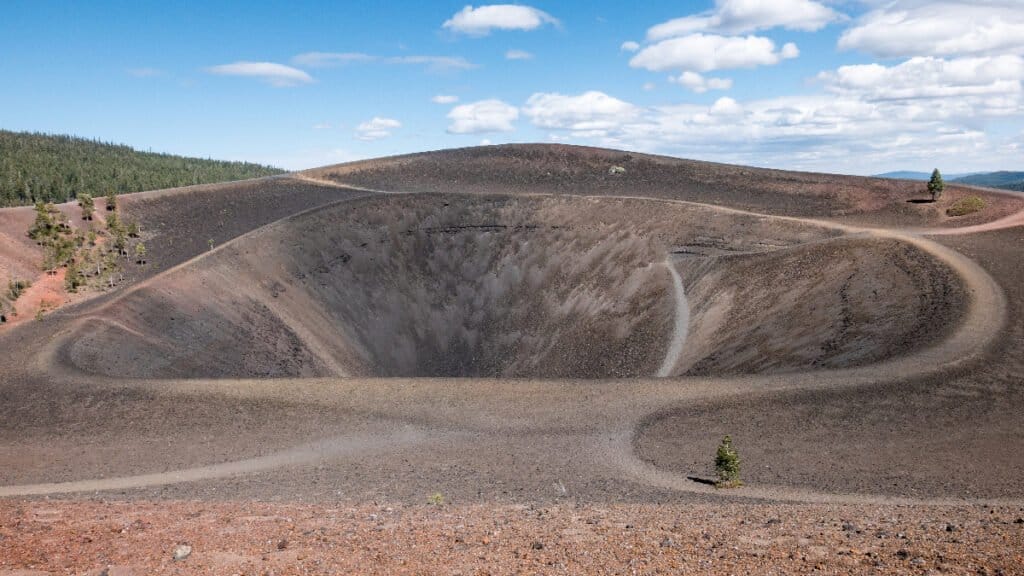
Cinder cone volcanoes are made up of pyroclastic fragments that form the tunnel where lava erupts
©lrosebrugh/Shutterstock.com
When a volcano erupts, it shakes loose a lot of rock fragments. These rock fragments are called pyroclastic fragments, and these are considered volcano composites and differ from ordinary rocks because of their components.
These pyroclastic fragments are what form cinder cone volcanoes. This volcano is cylindrical in shape and creates the vent from which lava erupts. Usually, the top of the volcano has a deep bowl-like crater that has grown outward from the force.
The way this works is pretty fascinating, as rocks form their own tunnel after each eruption and shape the inside of the volcano. Cinder cone volcanoes tend to look beautiful inside as the stones are made up of lava fragments and can have that pretty, glassy look to them.
The cinder cone volcano is the most common type of volcano you will come across. They are also smaller than the average volcano and generate significantly less force, especially when they experience an eruption.

Cinder cone volcanoes typically have a cylindrical vent on their top.
©Stan Jones/Shutterstock.com
Eruptions are manufactured in a reasonably simple way.
- First, gas pushes up the shoot, or the cone, from the magma churning deep below.
- Second, cinders and volcanic ash are pushed out of the way by the gas.
- Third, the wind pulls the ash and cinders out over the land beyond the volcano.
- Fourth, lava pulses from the volcano and rides in rivers down the volcano til it cools, becoming a new surface.
The way this type of volcano forms and erupts is a miraculous occurrence!
2. Complex Volcanoes

Complex volcanoes are known as such because they form irregularly and can have several vents.
©travelwild/Shutterstock.com
A complex volcano forms from another more miniature volcano over time. That’s why they are called complex, or compound, volcanoes.
They are made of lava flow material and pyroclastic rock, which we now know comes from when volcanic gasses blow up so hard they break rocks apart and magma breaks through the surface. They aren’t specifically one material or another.
Instead, complex volcanoes are composed of a wide range of materials from eruptions over time. The way lava flows and material falls can change the direction of the vent and shape the volcano in unique ways.
One of the reasons these volcanoes are referred to as complex volcanoes is because they don’t look alike. Since these volcanoes grow so differently, they are complex in their formations. Over time, the volcano’s vent can shift, and the magma releases in a different place.
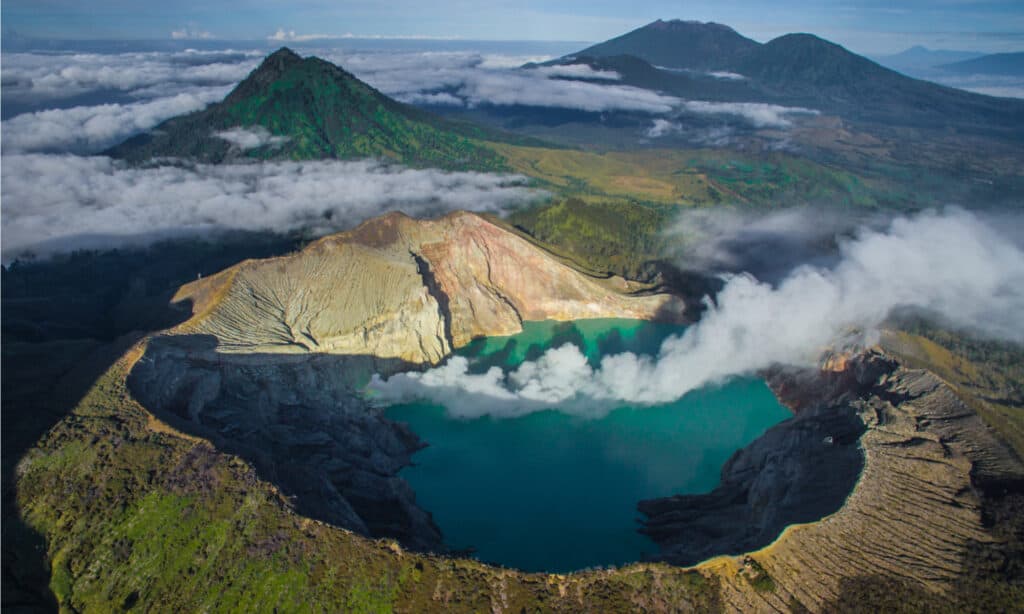
Volcanic complexes can have several peaks that are connected to one another
©Putu Artana/Shutterstock.com
In the image above, you can see a volcanic complex from Indonesia. Notice how numerous vent points have formed over time and the presence of multiple peaks.
3. Composite/Strato-volcanoes
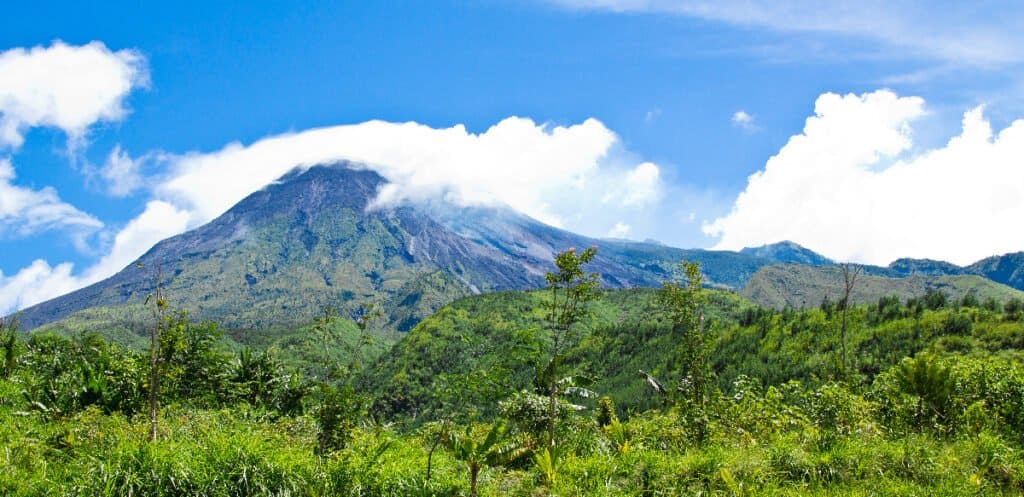
Strato-volcanoes are made of composite material from when lava escapes fissures and flows freely down the volcano, helping it expand and reshape
©Meister Photos/Shutterstock.com
Like complex volcanoes, strato-volcanoes are formed from eruptive material the earth spits out. These volcanoes tend to be much older than other volcanoes and are not as common due to the thousands of years and hundreds of eruptions necessary to form the material they’re composed of.
Strato-volcanoes are likely the volcano you picture when you read the word volcano. They are tall and have a cone-like shape. When lava, which is hotter than any other material on earth, flows through the cracks of the volcano, it changes its shape.
The cone of the strato-volcano is made up of composite material, escaped lava, and pyroclastic rock. The layers build the volcanoes up over time.
These volcanoes mostly erupt over time at a reasonable consistency. However, they can also feature some of the more notable eruptions in recent memory. For example, Washington‘s Mount St. Helens is a strato-volcano that had a major eruption in 1980. Most of the ‘ring of fire’ that stretches across the Pacific is strato-volcanoes.
Strato-volcanoes tend to form calderas, craters at their tips that have collapsed into themselves. Calderas appear as a hollow place in a crater after it has been emptied of magma.
Calderas are basically sinkholes inside the tops of volcanoes that form from the pressure of the magma and its release. This reshapes the inside of the volcano, while the leaking magma changes the outside of the volcano.
4. Shield Volcanoes
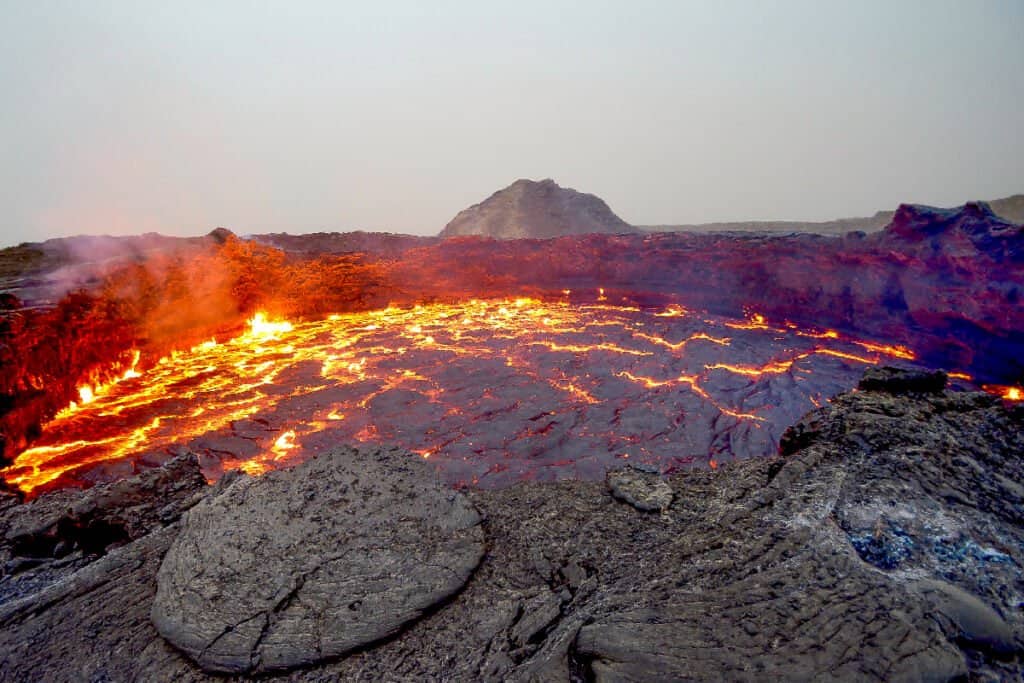
Shield volcanoes are named such because their lava flows outward instead of upward, forming a large volcano that is spread out in a shield-like design
©mbrand85/Shutterstock.com
As the largest type of volcano, the shield volcano is also the most volatile of volcanoes.
The reason these are called shield volcanoes is pretty easy to figure out. Instead of a substantial dramatic explosion puffing ash and rock into the air, these eruptions are softer. This doesn’t mean they are any less damaging, though.
The lava that seeps out of the volcano spreads out at great distances, meaning it extends outward for miles even though it doesn’t have a heavy peak. The Hawaiian islands are actually made up of shield volcanoes.
Since these volcanoes have softer explosions with less debris drifting outward, it’s easier to live in their shadow. One just needs to know not to live in the parts of the volcano closest to where the lava flows.
The lava that creates the shield volcanoes is not as strong as other lava pushed up with gas, and that’s part of why it flows in a much more gentle manner than with other volcanoes, and it’s a much thinner form of lava.
The material of a shield volcano isn’t as varied as with other volcanoes since it is just the weak lava that has flowed over itself over the years. These volcanoes often have calderas or sinkholes within the peak.
Many of the 6 active volcanos in Hawaii are considered shield volcanoes. Imagine living at the base of a volcano that erupts regularly. You’d have to be brave and prepared at all times in case the volcano decides to spread further than it has before. It’s even possible to hike up an active volcano in Hawaii if you dare!
5. Spatter Cone Volcanoes
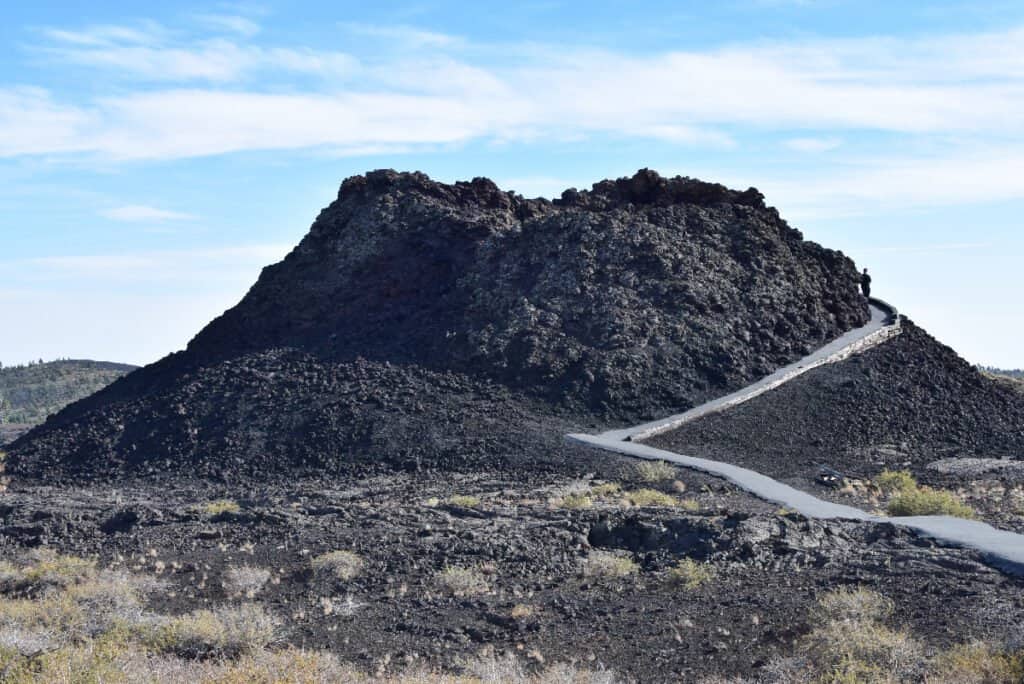
Spatter cone volcanoes are made up of rocks they erupt, becoming welded together
©Rui Serra Maia/Shutterstock.com
The spatter cone type of volcano is a particularly exciting volcano because it is formed from volcano fragments welded together in a beautiful structure. Like in other volcanoes, gases push upward from the magma and blow up large chunks of volcanic rock.
They have a tendency to overflow and push out magma into outlying areas. The lava travels over the spatter cone mound to form new folds of the small peak.
Spatter cones, when not active, tend to resemble an ant mound. Over time, the mound grows into a volcano because the original vent spitting up magma and rocks releases more and more, and those rocks build the volcano we see.
As the rocks weld together, the structure of the volcano forms. Over time, they push the volcano upward and give the sides a nice, steep edge. Even though they don’t grow larger than about 30 feet, they genuinely do leave an impression.
The rocks that these volcanoes blow outward are called the spatter, or agglutinate. This is why they are called spatter cones. Because the material just splatters outward and forms the volcano.
Sometimes people wonder about the difference between splatter cone volcanoes and cinder cone volcanoes. Cinder cones are made up of rocks you can pull apart, while spatter cone volcanoes are welded together, and you can’t pick up any pieces
The photo featured at the top of this post is © fboudrias/Shutterstock.com
FAQs (Frequently Asked Questions)
What types of volcanoes are there in California?
There are 20 volcanoes in California and 7 of them are active. These include examples of each of the 5 types of volcanoes.
What are some extinct volcanoes?
There are extinct volcanoes across the world. Some examples include Ben Nevis in the UK, Waw en Namus in the Sahara Desert, Tamu Massif in the Pacific Ocean, and Mount Slemish in Ireland.
Thank you for reading! Have some feedback for us? Contact the AZ Animals editorial team.







